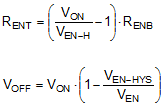SNVSBD7A October 2019 – February 2020 LMR36510
PRODUCTION DATA.
- 1 Features
- 2 Applications
- 3 Description
- 4 Revision History
- 5 Pin Configuration and Functions
- 6 Specifications
- 7 Detailed Description
- 8 Application and Implementation
- 9 Power Supply Recommendations
- 10Layout
- 11Device and Documentation Support
- 12Mechanical, Packaging, and Orderable Information
Package Options
Mechanical Data (Package|Pins)
- DDA|8
Thermal pad, mechanical data (Package|Pins)
- DDA|8
Orderable Information
8.2.1.2.9 External UVLO
In some cases, an input UVLO level different than that provided internal to the device is needed. This can be accomplished by using the circuit shown in Figure 14. The input voltage at which the device turns on is designated VON and the turnoff voltage is VOFF. First, a value for RENB is chosen in the range of 10 kΩ to 100 kΩ and then Equation 10 is used to calculate RENT and VOFF.
 Figure 14. Setup for External UVLO Application
Figure 14. Setup for External UVLO Application Equation 10. 

where
- VON = VIN turnon voltage
- VOFF = VIN turnoff voltage